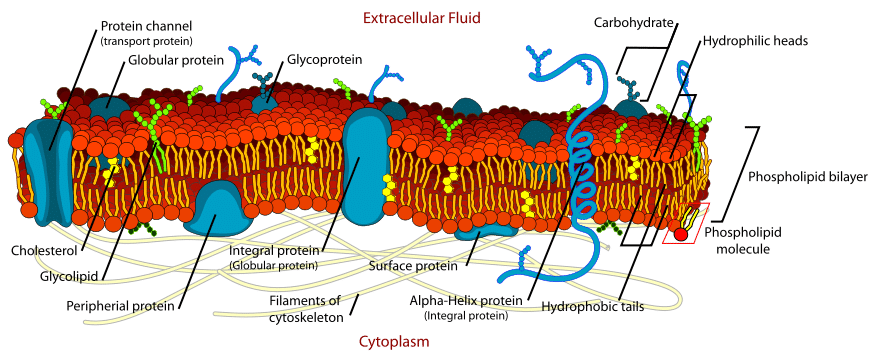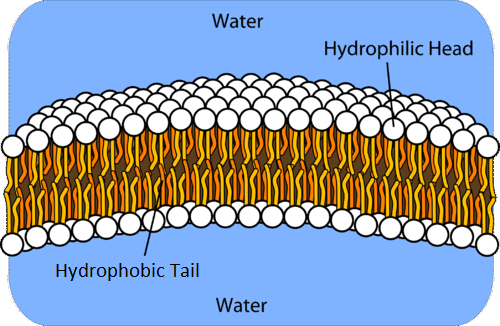Describe the Structure of Phospholipids in Cell Membranes.
Phospholipids like to line up and arrange themselves into two parallel layers called a phospholipid bilayer. The chemical groups are water loving and water hating substances.

The Cell Membrane Structure Phospholipids Teachmephysiology
In the case of the plasma membrane these compartments are the inside and the outside of the cell.

. Describe the structure of phospholipids in cell membranes. Phospholipids make up the basic structure of a cell membrane. Describe the fluid mosaic structure of cell membranes.
Click card to see definition. All membranes within and around cells have the same structure. A single phospholipid molecule has two different ends.
This means that it likes or is attracted to water molecules. PROTEINS interspersed and embedded in two ways-In the surface act to give mechanical support or cell. Some cells may have membrane components found only in that specific cell type.
The phospholipids are arranged in a double layer within the membranes which allows the hydrophilic ends of the molecules to come in contact with the water inside and outside the cell. A head and a tail. Tap card to see definition.
The plasma membrane is made up primarily of a bilayer of phospholipids with embedded proteins carbohydrates glycolipids and glycoproteins and in animal cells cholesterol. A head and a tail. These membranes have PHOSPHOLIPIDS in a BILAYER-hydrophilic heads point to the outside as attracted by water on both sides-hydrophobic tails are repelled to point inwards.
The fluid mosaic model of the plasma membrane structure describes the plasma membrane as a fluid combination of phospholipids cholesterol proteins and carbohydrates. Just to briefly remind us our phospholipid is often drawn like this. Phospholipids form a lipid bilayer in which their hydrophilic attracted to water head areas spontaneously arrange to face the aqueous cytosol and the extracellular fluid while their hydrophobic repelled by water tail areas face away from the cytosol and extracellular fluid.
The fluid mosaic model describes the structure of the plasma membrane as a mosaic of components including phospholipids cholesterol proteins and carbohydratesthat gives the membrane a fluid character. The phospholipids can make the structure of cell membranes because of the chemical groups ie hydrophilic and hydrophobic. The multitude of different proteins and lipids in the cell membrane give it the look of a mosaic.
They can form lipid bilayers because of their amphiphilic characteristic. In some cases it is not the identity of the component but the number of specific components found on a certain type of cell that distinguishes it from other cells. The landscape of the membrane is studded with proteins some of which span the membrane.
Phospholipids are amphipathic double-charged molecules composed of one glycerol molecule one phosphate group and two fatty acid units. Scientists use the fluid mosaic model to describe the structure of the cell membrane. The membrane bilayer contains many kinds of phospholipid molecules with different sized head and tail molecules.
These consist of a head molecule a phosphate molecule a glycerol and two fatty acid chains. Phospholipids are composed of a phosphate group head and also two fatty acids which consist of hydrogen and carbon. The tail end is made up of two strings of hydrogen and carbon atoms called fatty acid chains.
The head end contains a phosphate group and is hydrophilic. The modern understanding of the plasma membrane is referred to as the fluid mosaic model. The plasma membrane is composed of a bilayer of phospholipids with their hydrophobic fatty acid tails in contact with each other.
A phospholipid is a lipid molecule composed of two fatty acid tails. The phospholipid is essentially a triglyceride in which a fatty acid has been replaced by a phosphate group of some sort. It has that polar phosphate head group and it has two fatty acid chains.
There are also embedded proteins in lipid bilayer forming mosaic like shape. The cell membrane has a fluid consistency due to being made up in large part of phospholipids and because of this proteins move freely across its surface. Phospholipids make up the basic structure of a cell membrane.
Structure of the Cell Membrane. Phospholipids are a class of lipids that are a major component of all cell membranes. The fundamental structure of the membrane is the phospholipid bilayer which forms a stable barrier between two aqueous compartments.
The structure of the phospholipid molecule generally consists of two hydrophobic fatty acid tails and a hydrophilic head consisting of a phosphate group. A phospholipid is a lipid that contains a phosphate group and is a major component of cell membranes. In this video were going to actually explore in detail the structure of phospholipids in our cell membrane.
The plasma membrane is made up primarily of a bilayer of phospholipids with embedded proteins carbohydrates glycolipids and glycoproteins and in animal cells cholesterol. Heads of phospholipids are in outer side while tails are in inner portion of bilayer forming hydrophobic inside the bilayer and hydrophilic outer layersides of membrane. A phospholipid consists of a hydrophilic water-loving head and hydrophobic water-fearing tail see figure below.
They form a two-layer structure called the lipid bilayer with the polar head facing out on each surface to interact with water and the neutral tails driven inward and pointing toward one another. This means that it likes or is attracted to water molecules. The fluid mosaic model of the plasma membrane structure describes the plasma membrane as a fluid combination of phospholipids cholesterol proteins and carbohydrates.
This layer makes up your cell. And all of this is held together by glycerol backbone. The head end contains a phosphate group and is hydrophilic.
A single phospholipid molecule has two different ends. It is a lipid bilayer. Like all other cellular membranes the plasma membrane consists of both lipids and proteins.
As portrayed in the diagrammatic illustration above the glycerol molecule and the phosphate group makes up the hydrophilic head or the water-loving part of the phospholipid. Phospholipids are important in membranes phospholipid membrane because of their amphipathic nature containing both hydrophobic and hydrophilic groups. Phospholipids are a major component of cell membranes.
The tail end is made up of two strings of hydrogen and carbon atoms called fatty acid chains.

14 3 Phospholipids In Cell Membranes Chemistry Libretexts


No comments for "Describe the Structure of Phospholipids in Cell Membranes."
Post a Comment